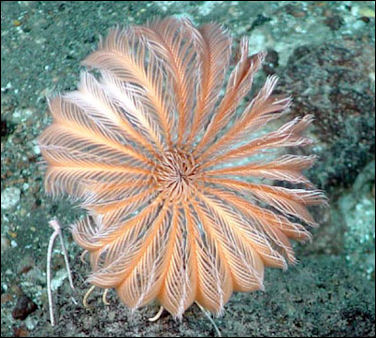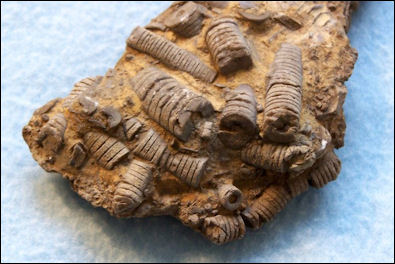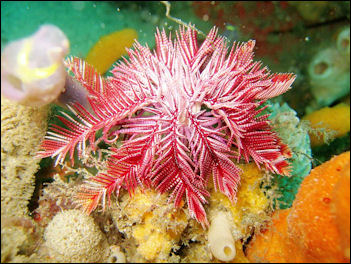Home | Category: Sea Slugs, Nudibranchs, Star Fish and Unusual Sea Life
CRINOIDS (FEATHER STARS, SEA LILIES)

Crinoid Crinoids (Feather stars, Scientific name: Crinoidea) are colorful sea creatures that have been described as "flowers of the coral seas." Sometimes called sea lilies and found in their highest concentrations around Indonesia, the Philippines and Australia's Great Barrier Reef, they make up a small class are echinoderms, a phylum that includes starfish, sea urchins and sea cucumbers. There about 600 species of crinoid. [Source: Fred Bavendam, National Geographic, December, 1996]
Crinoids cansometimes be amazingly abundant. Many crinoids live in the deep sea, but others are common on coral reefs. Some species of crinoid reach three feet in diameter and have 200 or more feathery arms. Found in reefs, shallow pools and deep sea trenches, they come in a rainbow of colors, including yellow, orange, red, green and white. In 1999, a colony of crinoids was found nine kilometers below the ocean surface in Izu-Ogasawara Trench off Japan.
Crinoids can attach themselves to a rock like a plant or swim freely in the sea. Most species hide under rocks, in crevices and under coral ledges, coming out only at night and slowly across hard surfaces to find good places to feed. Crinoids are gonochoric (having separate sexes, not hermaphroditic) and brood their young until the embryo develops into a doliolarian larva or a fully formed juvenile crinoid. A few species swim is manner described as a dance of "undulated sweeps of alternate arms.”
Related Articles: DIFFICULT-TO-CLASSIFY MARINE ANIMALS: SEA SQUIRTS, PHORONIDS, BRYZOANS AND BRACHIOPODS ioa.factsanddetails.com ; MARINE WORMS: POLYCHAETES, ANNELIDS AND FLAT, FIRE AND RIBBON WORMS ioa.factsanddetails.com ; WEIRD MARINE WORMS: PENIS FENCERS, PURPLE SOCKS AND TOXIC ONES 55 METERS LONG ioa.factsanddetails.com
Websites and Resources: Animal Diversity Web (ADW) animaldiversity.org; National Oceanic and Atmospheric Administration (NOAA) noaa.gov; Fishbase fishbase.se; Encyclopedia of Life eol.org; Smithsonian Oceans Portal ocean.si.edu/ocean-life-ecosystems ; Monterey Bay Aquarium montereybayaquarium.org ; MarineBio marinebio.org/oceans/creatures; Websites and Resources on Coral Reefs: Coral Reef Information System (NOAA) coris.noaa.gov ; International Coral Reef Initiative icriforum.org ; Coral Reef Alliance coral.org ; Global Coral reef Alliance globalcoral.org ; Global Coral Reef Monitoring Network gcrmn.net
Crinoid Fossils
Modern crinoids look almost exactly like their 250-million-year-old ancestors. They evolved from creatures that first appeared 500 million years ago. All but one of the nine to eleven subclasses of crinoids are now extinct and are known only through their sometimes impressive fossils. Approximately 5,000 species of fossil crinoids are known, with the greatest diversity from the Paleozoic Period (541 million to 252 million years ago). By the end of the Permian Period (299 million to 252 million years ago), however, only one lineage seems to have survived. The only surviving subclass of crinoids is the Articulata. [Source: Derek Kellogg and Daphne G. Fautin, Animal Diversity Web (ADW)]

Crinoid fossil Alice Clement of Flinders University wrote: Crinoids are known from at least the Devonian (359-419 million years ago) but may have existed as long ago as the Ordovician (more than 445 million). These marine animals, also known as “sea lilies”, once lived on the seafloor in a symbiotic relationship with corals. Corals grew off the stalks of crinoids to reach higher into the water column for better feeding opportunities. [Source: Alice Clement, Research Associate in the College of Science and Engineering, Flinders University, The Conversation October 10, 2022]
This association was very common until it seemingly stopped appearing in the fossil record about 273 million years ago. However, in 2021 these two marine creatures were rediscovered in Japanese waters, thriving in a blissful aquatic partnership. It remains a mystery why no fossil evidence of this happy marriage had been found for the intervening period.
Crinoid Characteristics
Crinoids have no brain or eyes but their well developed nervous system allows them to sense movement, light and food. On the arms of most species are dozens of tube feet covered with sticky mucus that traps food that moves down grooves toward the mouth. The tube feet also absorb oxygen from the water.
According to Animal Diversity Web: In most extant crinoids, primarily the shallow-water ones, there are two body regions, the calyx and the rays . The calyx is the cup-shaped central portion that lies below the oral surface, which is oriented away from the substrate; most of the organs are found in the calyx. Both the anus and the mouth open on the oral surface, but the anus is easily distinguished by being located atop an ossified cone set peripherally on the oral surface. The rays are long arm-like extensions from the calyx that are used for feeding. Each ray has a lateral row of short branches on either side; these pinnules increase the surface area and trap food. Some deep-sea crinoids have a third body portion, the stalk . It serves to anchor the crinoid to the substrate. [Source: Derek Kellogg and Daphne G. Fautin, Animal Diversity Web (ADW)
.jpg)
feather star
The stalk is largely comprised of stacked calcite disks that are common fossils in limestone. Another conspicuous feature of many criniods are long, thin protrusions called cirri . In unstalked crinoids, the cirri are located on the end of the calyx opposite the mouth, and are used by the animal to grasp the substratum. Cirri of stalked crinoids extend from the stalk; they also seem to function in adhesion. The calcitic ossicles of crinoids, as is typical of echinoderms, form an internal skeleton that provides support and protection. /=\
A crinoid's internal anatomy is dominated by organs for digestion and reproduction. The entire digestive system lies within the calyx and is characterized by little more than a mouth and intestine with diverticula. The coelom extends into the rays, where the sex organs are located. Nerves occur throughout the animal, but the mass found in the calyx seems to be the center for regeneration of lost body parts. Excretion may be accomplished through small tubes called saccules located near the ambulacral grooves, but the mechanism for this is poorly understood. /=\
Crinoid Feeding, Movement and Predators
All Crinoids are filter feeders that wait for plankton, algae, small crustacean and other organic materials to be pushed their way by currents. During the day they keep all their arms bound tightly together in a tight ball. At night they crawl slowly from their daytime hiding places, taking as long as half an hour to make the march, and then unfurl their arms, ideally positioning themselves at right angles to the current, so a lot of food comes their way, and swaying gently while feeding.
Food particles are moved by the tube feet down the ambulacral groove of a ray toward the mouth. Modified ossicles called lappets that border the ambulacral groove function to close off the groove and prevent damage to the tube feet. The rays of crinoids are also important for locomotion. By moving their rays up and down through contraction and relaxation of muscles, crinoids are able to swim slowly through the water.[Source: Derek Kellogg and Daphne G. Fautin, Animal Diversity Web (ADW)]
Crinoids are rarely are attacked by fish. They are composed of few edible parts and their spiny surfaces emit mucus that is sometimes toxic to fish. Crinoids sometimes provide homes for small fish and shrimp, often colored the same as their hosts. Some species like the Merlet's scorpionfish have lacy fringes that mimic crinoid arms.
Sea Pens

Passion Flower feather star Sea pens are considered to be a kind of soft coral. They are ancient, primitive water creatures that were given their names in an age when people wrote with quill pens. They have a flexible, horny stem and feathery appendages. They vary in height from a few centimeters to about a meter.
Sea pens are colonial marine cnidarians belonging to the order Pennatulacea. There are 14 families within the order and 35 extant genera; it is estimated that of 450 described species, around 200 are valid. Sea pens are particularly interesting at night. Many kinds glow with a bright purple luminescence. If you touch them, waves of light pulsate along their arms sort of like some of the plants in the film “Avatar”.
Sea pens are widely distributed. They can be found in tropical and temperate waters worldwide from near the ocean surface and the intertidal to depths of more than 6100 meters (20,000 feet). Sea pens are grouped with the octocorals, together with sea whips (gorgonians). Sea pens can reach a height of about 70 centimeters. Their “feathers” house polyps that snag zooplankton, fish and jellyfish that float its way. If threatened they expel pulses of water that fill up their bodies or hide in mud or a crevice of a rock.
Their wide geographic distribution is due in part to their ability to inflating themselves with seawater which causes them to get carried by the currents, Because of this there is genetic variation within the different species of sea pens. There are many populations of sea pens in Indian waters.
Sea Pen History
Although sea pens are named for their supposed resemblance to antique quill pens, only sea pen species belonging to the suborder Subselliflorae live up to the comparison. Those belonging to the much larger suborder Sessiliflorae lack feathery structures and grow in club-like or radiating forms. The latter suborder includes what are commonly known as sea pansies. [Source: Wikipedia]
The earliest accepted fossils are known from the Burgess Shales, which date to the Middle Cambrian Epoch (520 million to 512 million years ago. Similar fossils from the Ediacaran Period (635 million to 542 million years ago) may reflect the dawn of sea pens. Precisely what these early fossils are, however, is still a matter of scholarly debate.
One of the rarest and most expensive fabrics in ancient times was the silky golden thread spun by sea pens. This shimmering cloth was a thousand times more valuable than silk which itself was worth as much, pound for pound, as gold. Today, Sea pens are sometimes sold in the aquarium trade. However, they are generally hard to care for because they need a very deep substrate and have special food requirements.
Sea Pen Characteristics
Sea pens are colonial animals with multiple polyps, which each have eight tentacles and look sort of like miniature sea anemones. Sea pen polyps have specialized functions: a single polyp develops into a rigid, erect stalk (the rachis) and loses its tentacles, forming a bulbous "root" or peduncle at its base. The other polyps branch out from this central stalk, forming water intake structures (siphonozooids), feeding structures (autozooids) with nematocysts, and reproductive structures. The entire colony is fortified by calcium carbonate in the form of spicules and a central axial rod. [Source: Wikipedia]
Using their root-like peduncles to anchor themselves in sandy or muddy substrate, the exposed portion of sea pens may rise up to two meters (6.6 feet) in some species, such as the tall sea pen (Funiculina quadrangularis). Sea pens are sometimes brightly coloured; the orange sea pen (Ptilosarcus gurneyi) is a notable example. Rarely found above depths of 10 meters (33 feet), sea pens prefer deeper waters where turbulence is less likely to uproot them. Some species may inhabit depths of 2,000 meters (6,600 ft) or more.
While generally sessile animals that stay in one place, sea pens are able to relocate and re-anchor themselves if necessary. They position themselves in the path of currents, ensuring a steady flow of plankton, the sea pens' chief source of food. Their primary predators are nudibranchs and sea stars, some of which feed exclusively on sea pens. The sea pens' ability to be clumped together and spatially unpredictable hinders the ability of sea stars to prey on them. When touched, some sea pens emit a bright greenish as bioluminescent light. They may also force water out of their bodies for defence, rapidly deflating and retreating into their peduncle. Some sea pens exhibit glide reflection symmetry, rare among non-extinct animals.
Sea pens employ broadcast (group) spawning, the main mode of reproduction in the sea. It involves the release of both eggs and sperm into the water and contact between sperm and egg and fertilization occur externally. The Sea pens’ coordinated release of sperm and eggs may occur seasonally or throughout the year. Fertilized eggs develop into larvae called planulae which drift freely for about a week before settling on the substrate. Mature sea pens provide shelter for other animals, such as juvenile fish. Analysis of rachis growth rings indicates sea pens may live for 100 years or more, if the rings are indeed created on an annual basis.
Gorgorians (Sea Fans, Sea Whips)
Gorgonians are tree-like soft coral known as sea fans and sea whips that don't build reefs. They jut out from reef walls and catch plankton as it rises during the night and descends during the day. Gorgorians, like a jellyfish, are colonies of small individual organisms that behave like a larger organism. Their flexible skeletons drift in the currents and polyps grab food and feed it to a common digestive track.
Gorgonians are sessile colonial cnidarians that are found throughout the oceans of the world, especially in the deep sea, polar waters, tropics and subtropics. About 500 different species of gorgonians are found in the oceans of the world, but they are particularly abundant in the shallow waters of the Western Atlantic, including Florida, Bermuda, and the West Indies. [Source: Wikipedia]
In Gorgorians groups tiny individual polyps form colonies that are normally erect, flattened, branching, and reminiscent of a fan or whiplike, bushy, or even encrusting. A colony can be several feet high and across, but only a few inches thick. They may be brightly coloured, often purple, red, or yellow. Photosynthetic gorgonians can be successfully kept in captive aquaria. Other fauna, such as hydrozoa, bryozoa, and brittle stars, are known to dwell within the branches of gorgonian colonies. Pygmy seahorses not only makes their home in certain species of gorgonians they closely resemble their hosts, and thus are well camouflaged.
Gorgonians produce unusual organic compounds in their tissues, particularly diterpenes, and some of these are important candidates for new drugs. These compounds may be part of the chemical defenses produced by gorgonians to render their tissue distasteful to potential predators. Bottlenose dolphins in the Red Sea have been observed swimming against these tissues, in what is thought to be an attempt to take advantage of the antimicrobial qualities of diterpenes. Despite these chemical defenses, gorgonians are preyed up by flamingo tongue snails, certain species of nudibranch and the fireworm Hermodice spp. Their polyps are fed on by butterflyfishes.
Gorgorian Characteristics
The structure of a gorgonian colony varies. In the suborder Holaxonia, skeletons are formed from a flexible, horny substance called gorgonin. The suborder Scleraxonia species are supported by a skeleton of tightly grouped calcareous spicules. Also, some species encrust like coral. Measurements of the gorgonin and calcite within several long-lived species of gorgonians can be useful in paleoclimatology and paleoceanography, as their skeletal growth rate and composition are highly correlated with seasonal and climatic variation. [Source: Wikipedia
Each gorgonian polyp has eight tentacles, which catch plankton and particulate matter for consumption. This process, called filter feeding, is facilitated when the "fan" is oriented across the prevailing current to maximise water flow to the gorgonian, hence food supply. Some gorgonians contain algae, or zooxanthellae. This symbiotic relationship assists in giving the gorgonian nutrition by photosynthesis. Gorgonians possessing zooxanthellae are usually characterized by brownish polyps.
Gorgonians are found primarily in shallow waters, though some have been found at depths of several thousand feet. The size, shape, and appearance of gorgonians can be correlated with their location. The more fan-shaped and flexible gorgonians tend to populate shallower areas with strong currents, while the taller, thinner, and stiffer gorgonians can be found in deeper, calmer waters.
Image Sources: Wikimedia Commons, NOAA
Text Sources: Animal Diversity Web (ADW) animaldiversity.org; National Oceanic and Atmospheric Administration (NOAA) noaa.gov; Wikipedia, National Geographic, Live Science, BBC, Smithsonian, New York Times, Washington Post, Los Angeles Times, The New Yorker, Reuters, Associated Press, Lonely Planet Guides and various books and other publications.
Last Updated May 2023


